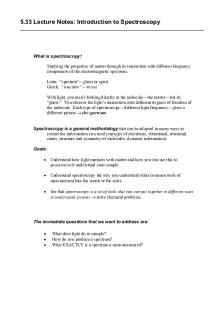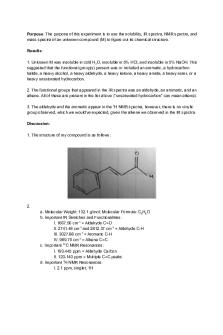Experiment 2-Sunscreen and UV Spectroscopy PDF

| Title | Experiment 2-Sunscreen and UV Spectroscopy |
|---|---|
| Course | (CHEM 2125, 2225, 2425) Organic Chemistry Laboratory |
| Institution | Texas A&M University |
| Pages | 2 |
| File Size | 93.5 KB |
| File Type | |
| Total Downloads | 114 |
| Total Views | 140 |
Summary
ochem 2 lab report for experiment 2...
Description
Sunscreens and Ultraviolet Spectroscopy Results: In this experiment, ultraviolet spectroscopy was performed for the active ingredients found in 10 different sunscreens in order to observe their UV-absorbing characteristics. Solution #8 (Neutrogena Ultrasheer dry-though with helioplex) was personally assigned. The table below displays the data obtained for all 10 sunscreen preparations. Sunscree n 1 2 3 4 5 6 7 8 9 10
Average absorbance at 310 nm 360 nm 0.713 0.527 0.830 0.544 1.292 0.635 0.387 0.341 0.500 0.341 0.577 0.280 0.796 0.523 0.762 0.444 1.081 0.693 1.134 0.434
the highest percent of ingredient (compound name)* Homosalate Homosalate Homosalate Homosalate Homosalate Homosalate Homosalate Homosalate Homosalate Homosalate
UVA or UVB**
UVB UVB UVB UVB UVB UVB UVB UVB UVB UVB
Discussion: Ultraviolet spectroscopy involves a part of the energy beam being absorbed by certain molecules. This occurs when electrons found in the low-energy orbitals excite into the orbitals of higher energy. This ultimately causes an absorption of energy in the UV designed region of the electromagnetic radiation. UV can be absorbed by conjugated systems in order for more to be known about the conjugated portion of a molecule. UV spectroscopy involves many relationships between the different forms of spectral data. The first and one of the most important relationships is observed in Beer’s law ( A=εlc ). This equation shows the relationship between the absorbance of a sample, it’s concentration in ( c -mol/L), molar extinction coefficient ( ε how strongly the sample absorbs light at a specific wavelength), and the path length of light through the cell, or in this case the cuvette in centimeters ( l¿ . The concentration of the sample is directly proportional to the absorbance of that same sample. The second relationship is between wavelength and energy ( E=hv=hc / λ ). Energy of a wave is inversely proportional to its wavelength, therefore the greater the energy, the shorter the wavelength. In this experiment, the solution of sunscreen is diluted prior to performing UV spectroscopy. The solution must be diluted as a valid absorbance value cannot be obtained at high or low concentrations. If one looks at Beer’s law, they will understand that if concentration of the sample is too high, the absorbance value will be high and unreadable. Absorbance values are recorded at two different wavelengths 360 nm and 310 nm corresponding to two different UV regions, UVA and UVB. UVA wavelength range is from 315400 nm and health problems include immediate sunburn and premature skin aging. UVB wavelength range is from 290-315 nm and health problems include later seen intense sunburn, skin cancer, immunosuppression, etc. UVA rays have a longer wavelength than UVB rays. This
means that UVA rays have less energy than UVB rays. It is also observed that UVA rays are more penetrating than those of UVB. A majority of sunscreen products contain TiO2 or ZnO and these zinc and titanium products act as physical barrier that reflect the UVA and UVB rays coming from the sun instead of absorbing. The table below identifies the wavelength range and type of UV rays for each active ingredient found in the sunscreen samples. Ingredient Padimate O Ethylhexyl salicylate Octyl methoxycinnamate Homosalate Octocrylene Oxybenzone Avobenzone Menthyl anthranilate Ecamsule
Wavelength region (nm) 290-315 nm 280-320 nm 290-320 nm 295-315nm 250-360 nm 270-350 nm 320-400 nm 260-380 nm 280-400 nm
UVA or UVB UVB UVA and UVB UVA and UVB UVB UVA and UVB UVA and UVB UVA UVA and UVB UVA and UVB
All 9 ingredients have multiple conjugated bonds, some more than others. This allows them to absorb UVA and/or UVB rays. From the experiment, it was observed that the ingredient that absorbs UVA rays the best is avobenzone, and the ingredient that best absorbs UVB rays is Padimate O. Another important relationship in UV spectroscopy is the one between energy, wavelength, and conjugation. When the molecule is less conjugated, the energy difference increases and the wavelength decreases.
Sources of Error: A possible source of error could be improper use of Kimwipes when wiping down the cuvettes. This could have resulted skewed data, as fingerprints on the cuvette and contamination can lead to inaccurate absorbance values. Another possible error could be the evaporating the sample due to allowing too much time to pass by before obtaining the spectrum. Evaporation of the product would increase concentration of the sample, therefore increasing absorbance values.
Conclusion: For this experiment, 9 active ingredients and their UV-absorbing characteristics found in 10 different sunscreen samples were observed after UV spectroscopy was performed. It was observed that Avobenzone best absorbed UVA rays and that Homosalate best absorbed UVB rays. In conclusion, this experiment was successful in identifying differences between the UVabsorbing characteristics of the active ingredients in sunscreen and their UV-related qualities....
Similar Free PDFs

UV Spectroscopy - Summary
- 4 Pages

UV-Vis Spectroscopy Caffeine
- 10 Pages

Spectroscopy
- 5 Pages

Mass Spectroscopy
- 14 Pages

Spettroscopia UV
- 29 Pages

Spectroscopy Lab
- 2 Pages
Popular Institutions
- Tinajero National High School - Annex
- Politeknik Caltex Riau
- Yokohama City University
- SGT University
- University of Al-Qadisiyah
- Divine Word College of Vigan
- Techniek College Rotterdam
- Universidade de Santiago
- Universiti Teknologi MARA Cawangan Johor Kampus Pasir Gudang
- Poltekkes Kemenkes Yogyakarta
- Baguio City National High School
- Colegio san marcos
- preparatoria uno
- Centro de Bachillerato Tecnológico Industrial y de Servicios No. 107
- Dalian Maritime University
- Quang Trung Secondary School
- Colegio Tecnológico en Informática
- Corporación Regional de Educación Superior
- Grupo CEDVA
- Dar Al Uloom University
- Centro de Estudios Preuniversitarios de la Universidad Nacional de Ingeniería
- 上智大学
- Aakash International School, Nuna Majara
- San Felipe Neri Catholic School
- Kang Chiao International School - New Taipei City
- Misamis Occidental National High School
- Institución Educativa Escuela Normal Juan Ladrilleros
- Kolehiyo ng Pantukan
- Batanes State College
- Instituto Continental
- Sekolah Menengah Kejuruan Kesehatan Kaltara (Tarakan)
- Colegio de La Inmaculada Concepcion - Cebu









